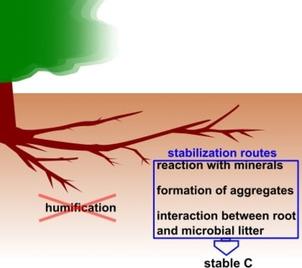当前位置:
X-MOL 学术
›
Chemistryopen
›
论文详情
Our official English website, www.x-mol.net, welcomes your
feedback! (Note: you will need to create a separate account there.)
Mechanisms of Carbon Sequestration in Highly Organic Ecosystems - Importance of Chemical Ecology.
ChemistryOpen ( IF 2.5 ) Pub Date : 2020-04-14 , DOI: 10.1002/open.202000015 Bartosz Adamczyk 1 , Jussi Heinonsalo 2, 3, 4 , Judy Simon 5
ChemistryOpen ( IF 2.5 ) Pub Date : 2020-04-14 , DOI: 10.1002/open.202000015 Bartosz Adamczyk 1 , Jussi Heinonsalo 2, 3, 4 , Judy Simon 5
Affiliation

|
Organic matter decomposition plays a major role in the cycling of carbon (C) and nutrients in terrestrial ecosystems across the globe. Climate change accelerates the decomposition rate to potentially increase the release of greenhouse gases and further enhance global warming in the future. However, fractions of organic matter vary in turnover times and parts are stabilized in soils for longer time periods (C sequestration). Overall, a better understanding of the mechanisms underlying C sequestration is needed for the development of effective mitigation policies to reduce land‐based production of greenhouse gases. Known mechanisms of C sequestration include the recalcitrance of C input, interactions with soil minerals, aggregate formation, as well as its regulation via abiotic factors. In this Minireview, we discuss the mechanisms behind C sequestration including the recently emerging significance of biochemical interactions between organic matter inputs that lead to C stabilization.
中文翻译:

高度有机生态系统中的碳封存机制 - 化学生态学的重要性。
有机物分解在全球陆地生态系统的碳 (C) 和养分循环中发挥着重要作用。气候变化加速了分解速度,有可能增加温室气体的释放,并在未来进一步加剧全球变暖。然而,有机物的比例在周转时间上有所不同,并且部分有机物在土壤中稳定的时间较长(碳封存)。总体而言,需要更好地了解碳封存的机制,以制定有效的缓解政策以减少陆地温室气体的产生。已知的碳封存机制包括碳输入的顽固性、与土壤矿物质的相互作用、团聚体形成及其通过非生物因素的调节。在这篇小综述中,我们讨论了碳封存背后的机制,包括最近出现的导致碳稳定的有机物质输入之间的生化相互作用的重要性。
更新日期:2020-04-14
中文翻译:

高度有机生态系统中的碳封存机制 - 化学生态学的重要性。
有机物分解在全球陆地生态系统的碳 (C) 和养分循环中发挥着重要作用。气候变化加速了分解速度,有可能增加温室气体的释放,并在未来进一步加剧全球变暖。然而,有机物的比例在周转时间上有所不同,并且部分有机物在土壤中稳定的时间较长(碳封存)。总体而言,需要更好地了解碳封存的机制,以制定有效的缓解政策以减少陆地温室气体的产生。已知的碳封存机制包括碳输入的顽固性、与土壤矿物质的相互作用、团聚体形成及其通过非生物因素的调节。在这篇小综述中,我们讨论了碳封存背后的机制,包括最近出现的导致碳稳定的有机物质输入之间的生化相互作用的重要性。











































 京公网安备 11010802027423号
京公网安备 11010802027423号